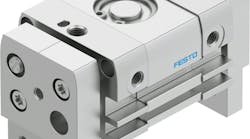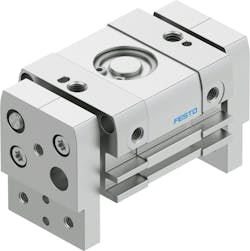The DHPL from Festo is a long-stroke, parallel pneumatic gripper designed for use in high load and torque applications.
Key benefits of the DHPL pneumatic gripper include:
- ≤ 0.03 mm repetition accuracy
- compact and lightweight design
- high load and torque grip
- flexible mounting options.
A High Performance, Compact Gripper
Festo developed the DHPL pneumatic gripper to be interchangeable with other long-stroke grippers in the market. Its compact and lightweight design makes it easy to install, including in today's machines which have a smaller overall footprint.
It is capable of providing a high level of precion for various applications such as stacking boxes, gripping plates and shaped parts as well as keeping bags open. Aiding this is the parallel gripper's ≤ 0.03 mm repetition accuracy which is posible due to the inclusion of three rugged guide rods and a rack and pinion design.
The gripper features force ratings from 40-750 N, helping it deliver the high load and torque grip required of various applications. A jaw stroke range from 20-200 mm is also beneficial for many machine solutions.
Several mounting options and sensor placement are possible with the GHPL gripper, offering design flexibility for machine builders and their customers. Positioning pin holes on the gripper help to ensure it mounts exactly where desired, further aiding installation for customers.
The gripper comes standard with pneumatic end-position cushioning which can be adjusted as desired. Customers can further customize the gripper to their application needs by adding fingers and brackets to enhance gripping capabilities. This is possible due to the jaw interaces on the DHPL.
READ MORE: Robotics Spur Growth in Grippers and Suction Cups



